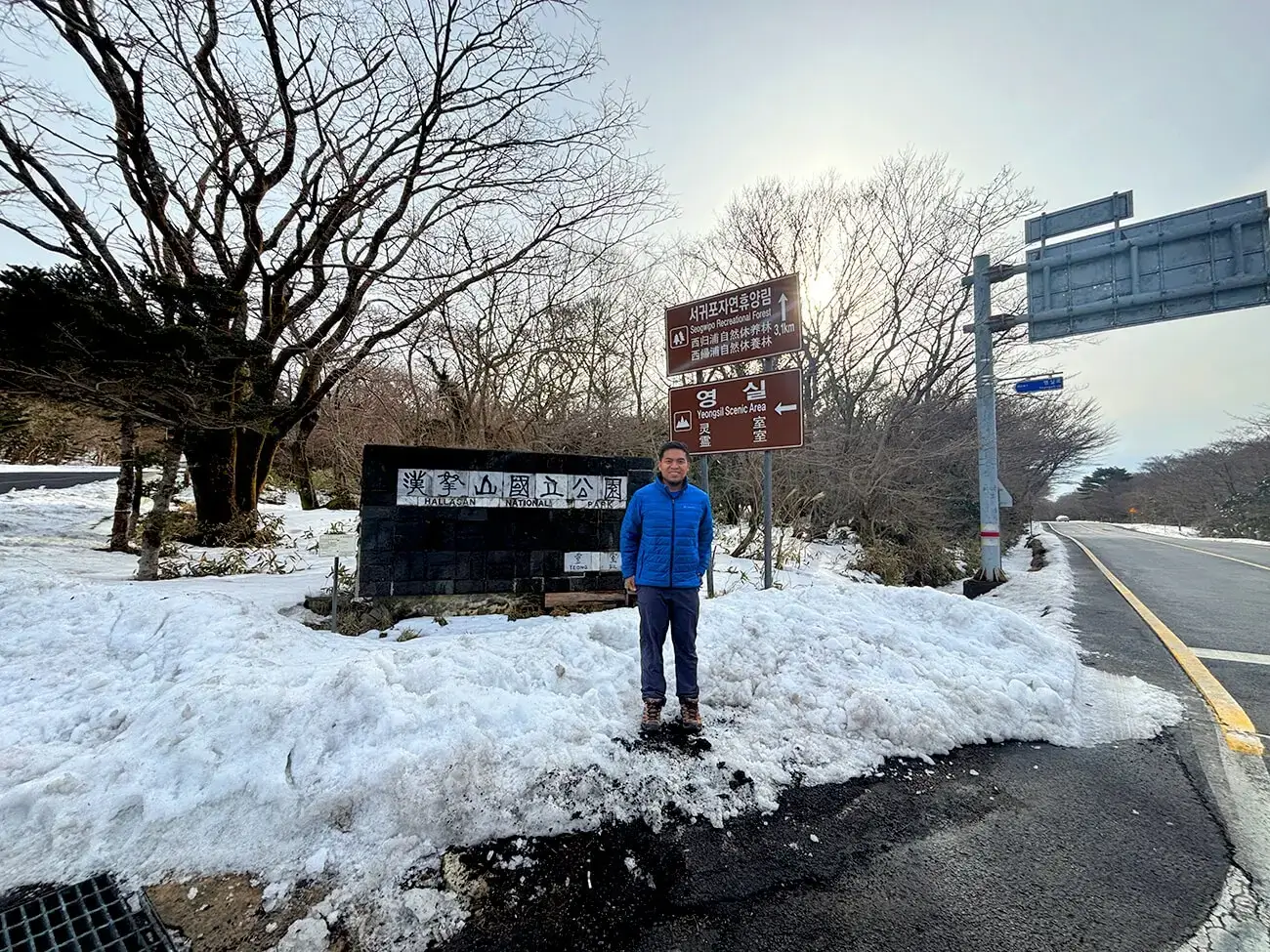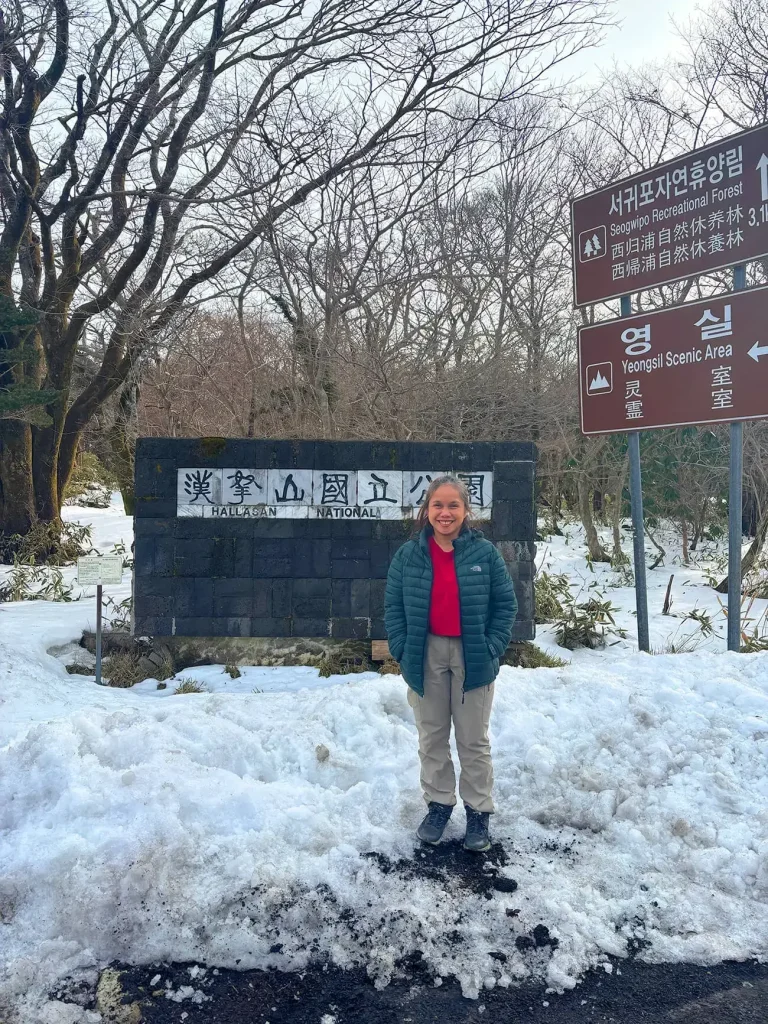Jeju Island, often dubbed the “Hawaii of South Korea,” is a volcanic paradise that draws nature lovers and adventure seekers alike. With dramatic cliffs, lush fields, and cascading waterfalls, the island’s stunning landscapes feel like something out of a dream. As a UNESCO World Heritage Site, Jeju offers the perfect blend of breathtaking views, rich culture, and exciting activities. This Jeju Island Travel Guide will help you uncover the very best the island has to offer—from iconic landmarks to hidden gems.
In this post, I’ll take you on a journey through my unforgettable adventure on Jeju Island—chasing waterfalls, exploring scenic spots, and diving into the island’s vibrant culture.
Table of Contents
Jeju Island Travel Guide: My Journey Through Korea’s Island Paradise
For this trip, my partner and I joined a tour with Jonah’s Travel, one of the top agencies for international trips. We decided to visit Jeju during the winter to experience the island’s charm in a whole new light—misty landscapes, a crisp chill in the air, and the chance to see snow.
One interesting fact about Jeju is that, although it’s part of South Korea, it’s visa-free for many travelers. This makes it an easy getaway for those who want to explore the island without the hassle of getting a visa.
Since there are no direct flights from Manila to Jeju, we took a connecting flight. We had options like Manila-Taiwan-Jeju or Manila-Singapore-Jeju, but chose the Manila-Hong Kong-Jeju route via Hong Kong Express.
The flight from Manila to Hong Kong took around 2.5 hours. After a four-hour layover, we boarded our next flight, which took another three hours to reach Jeju. We landed at 7 AM, with the sky still dark—Jeju is an hour ahead of Manila time.



Jeju Island Travel Guide: First Impressions & a Chill Stop at Starbucks Seogwipo
Since our Jeju Island travel guide tour bus was scheduled to arrive at 8 AM, we took some time to have a warm breakfast and withdraw Korean Won (KRW) for the day. Over coffee, we chatted and went over the itinerary, feeling excited and ready to kick off our Jeju adventure.
The tour bus arrived right on time, and as we stepped outside, a wave of cold air greeted us. Coming from a tropical climate, the crisp winter air was a stark contrast to what we were used to—it felt both refreshing and unfamiliar. We bundled up in our jackets, still adjusting to the chill, but the excitement of exploring a new place made it all the more invigorating.




Our first stop was Starbucks Seogwipo, located about an hour away by bus. While Starbucks is common in many countries, this branch had a unique charm—modern yet cozy, with large glass windows that offered a pleasant view of the surrounding area. We snapped a quick photo outside to mark the moment, then got back on the road, excited for our next destination: Seongsan Ilchulbong.





Jeju Island Travel Guide: Seongsan Ilchulbong: The Sunrise Peak
The drive to Seongsan Ilchulbong took about an hour, giving us plenty of time to enjoy the scenery. As we gained elevation, we passed a sign for Hallasan National Park and made a quick stop to take a few photos, with a beautiful snowfall providing the perfect backdrop for our Jeju Island travel guide journey.




Klook.com
Arriving in the afternoon, we were welcomed by cool weather despite the sun’s warmth. Seongsan Ilchulbong, or Sunrise Peak, is a volcanic tuff cone formed over 5,000 years ago. It’s renowned for its massive crater, and the summit offers one of the world’s most spectacular sunrise views.
The hike to the summit took about 20 to 30 minutes, with several scenic stops along the way. The views of Seongsan-ri below were mesmerizing, adding to the thrill of the climb. Once we reached the top, the panoramic view was even more breathtaking—the ocean stretched endlessly to the horizon.











After taking photos and soaking in the scenery, we began our descent. Though we had already taken plenty of pictures, we couldn’t resist stopping for more.
What was supposed to be a quick descent turned into a slow, deliberate walk, as we kept pausing to admire the landscape. In the end, what should have taken minutes stretched into over an hour and a half.
Back at the entrance, we explored nearby shops and indulged in classic Korean street food, including strawberry tanghulu, fish cakes, and corn dogs—a perfect way to wrap up the Jeju Island travel guide adventure.



Klook.com
Jeju Island Travel Guide: Noksan-ro Canola Flower Fields
After a quick snack, we boarded our bus and headed to our next destination—the Seongsan Canola Flower Field on Noksan-ro (Noksan Road). This picturesque spot is just a short drive from Seongsan Ilchulbong, making it an easy addition to our itinerary.
Noksan-ro is a long stretch of road lined with vibrant golden canola flowers, creating a breathtaking scene. I believe this location has even been featured in some Korean dramas, including When Life Gives You Tangerines.
Once we arrived, our group eagerly hopped off the bus and took our time capturing photos, immersing ourselves in the beauty of the endless fields of canola flowers. The bright yellow blooms against the blue sky made for a truly unforgettable view.




Klook.com
Jeju Island Travel Guide: Jeongbang Waterfall and Seogwipo Maeil Olle Market
Our group then made our way to Seogwipo for the final stop—Jeongbang Waterfall, where we would stay for the night. The journey took about an hour and a half, offering some time to rest or nap.
We arrived at the entrance to Jeongbang Waterfall around 4 PM and walked downhill toward the falls. The view of the ocean was stunning as we neared the waterfall, which cascades directly into the sea.
Jeongbang Waterfall is a popular tourist spot due to its unique location next to the ocean. After taking photos, our group headed back to the bus and continued to our hotel.




By 5 PM, we arrived at Hotel Gaon J Stay. After checking in and freshening up, we explored the area and headed to Seogwipo Maeil Olle Market for dinner.
The market was alive with energy, lined with stalls offering sizzling local delicacies, handmade crafts, and unique souvenirs. The aroma of street food filled the air, while the vibrant crowd and cheerful vendors added to the lively, welcoming atmosphere—a perfect glimpse into Jeju’s local culture.
After exploring the stalls and choosing what to try, we sat in an open dining area and enjoyed a variety of dishes, with some soju to complete the experience. After dinner, we returned to the hotel to rest for the next day’s hike up Mt. Hallasan.



Hallasan Hike: A Change of Plans
Our group woke up at 3 AM to prepare, and by 4 AM, we were on our way to Mt. Hallasan. The surroundings were dark and cold as we stepped out of the hotel, and even inside the bus, the chill of Jeju’s winter lingered. Fortunately, the bus had a heater to provide some warmth.
Klook.comAfter about an hour, we arrived at the jump-off point for Mt. Hallasan. As we stepped off the bus, the cold was noticeably harsher. Unfortunately, we were informed that the trail was closed due to severe weather conditions, making it unsafe to proceed.
With no other option, the group decided to return to the accommodation. Before leaving, we took a few quick photos at the entrance of Mt. Hallasan to mark the moment.




On the way back, there was a sense of disappointment, as the Hallasan hike had been one of the highlights we were most looking forward to. Thankfully, our tour organizer quickly came up with a backup plan. Instead of the hike, we would head to Ecoland Theme Park for a different kind of experience.
Jeju Island Travel Guide: Exploring Ecoland Theme Park
Getting to Eco Land Theme Park from Seogwipo takes about two hours and requires two bus rides. First, we went to the Seogwipo Jungang Rotary bus station and took Bus 182 to Jeju City, which took around 1 hour and 10 minutes. At the Jeju Bus Terminal, we switched to Bus 121, which took us to Namjo-ro Checkpoint, just a short walk from Eco Land. That second ride lasted about 30 minutes.


The fare ranges from ₩3,900 to ₩5,500. Note that bus schedules typically do not have English translations, making it harder to understand the destination markings.
Upon arrival, we bought adult tickets for ₩16,000 each. We then took a break for coffee to warm up before boarding the train to explore the park’s various stops.
Klook.comEcoland Hotel



We began at the first stop, crossing a bridge over a flowing stream. The winter air and vibrant foliage created a peaceful atmosphere. A bakery, café, art gallery, and souvenir shop added to the charm of the stop.
Continuing our walk, we captured scenic photos along the way. A Dutch-inspired windmill caught our attention, and we also found an iconic photo spot with a telephone booth and red petal-covered train tracks.















Next, we moved on to Winter Forest Station, which featured a hobbit house, café, and souvenir shop. After taking more photos, we boarded the train to Lavender, Green Tea & Rose Garden Station.





Although the Lavender, Green Tea & Rose Garden Station is known for colorful blooms, they weren’t in season during our visit. After strolling through the garden and taking photos, we boarded the train to return to the entrance.
Before leaving, we captured a few final shots in the snow-covered landscape, reflecting on our time at Eco Land. Tomorrow, we’ll be leaving Jeju Island with fond memories of the trip.




A Memorable Adventure
Despite the unexpected changes to our itinerary, Jeju Island exceeded all expectations. The stunning landscapes, rich culture, and spontaneous adventures made this trip truly unforgettable. Whether you visit in winter or any other season, Jeju offers a unique blend of nature, excitement, and relaxation that will leave you with memories to last a lifetime. And of course, we’ll be back—to try again and finally witness the breathtaking summit of Mount Hallasan.
Klook.com
Stay tuned for my next post, where I’ll share more about our side trip to Hong Kong and Macau before heading home!
Jeju Island Travel Guide Tips
- Plan for Weather Variability: Jeju’s weather can be unpredictable, especially in winter. While it can be chilly and snowy, temperatures can also vary depending on the region. Dress in layers and bring a light waterproof jacket to stay comfortable.
- Public Transport: If you’re planning to take public buses, be prepared for some language barriers. Bus schedules and destination markings might not have English translations, so it’s helpful to use apps like Google Maps or KakaoMap to navigate.
- Visa-Free Access: Jeju Island is a visa-free destination for travelers, which makes it an ideal quick getaway for those planning to visit South Korea without the hassle of obtaining a visa.
- Stay Flexible: Weather conditions can affect hiking schedules, especially in the winter months. Always have a backup plan, like visiting indoor attractions or exploring alternative outdoor sites, to make the most of your time.
- Pack Cash: While credit cards are accepted in most places, it’s always good to have some Korean Won (KRW) on hand, especially for small purchases or at local markets.
- Embrace Local Food: Jeju has a rich culinary culture. Don’t miss out on trying the island’s specialty dishes like black pork and Jeju tangerines. Visiting local markets like Seogwipo Maeil Olle Market is a great way to immerse yourself in the food scene.
- Stay Hydrated and Energized: With all the outdoor activities, be sure to carry water and snacks during hikes or long sightseeing days. This will keep your energy up as you explore the island.
If you enjoyed this travel story, don’t miss our other international adventures—each one is filled with inspiring journeys waiting to be discovered





